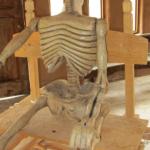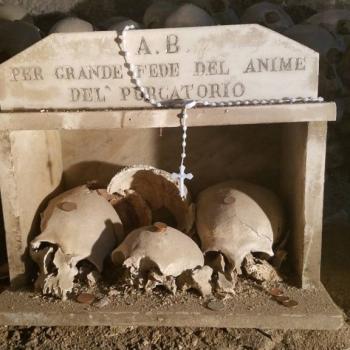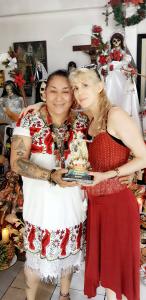
First published by Oxford University Press in 2012 with the second edition in 2017, my book Devoted to Death: Santa Muerte, the Skeleton Saint has been translated into both Spanish and Polish and now the Turkish edition is forthcoming this summer with Ganesha Press of Ankara. To that end I asked my research partner, Dr. Kate Kingsbury,* an Oxford-trained anthropologist of religion at the University of Alberta, to write the foreword for the Turkish edition. Dr. Kingsbury and I have co-authored numerous articles on the fastest growing new religious movement in the West and her forthcoming “Daughters of Death: The Female Followers of Santa Muerte” with Oxford University Press will be the next trailblazing book on the Mexican folk saint of death. – Dr. Andrew Chesnut
Santa Muerte – just the very name chills many to the bone. This is because after innumerable macabre depictions on the television and in the press the popular image of the Mexican folk saint of death is one of a nefarious divinity propitiated by narcotraffickers to hex their enemies and curse law enforcement. But in this seminal book on Santa Muerte, the result of over ten years of research across Mexico and the US interviewing devotees of death, Dr. R. Andrew Chesnut deconstructs this erroneous image of the fastest growing new religious movement in the Americas. Through the clever colour coding of each chapter by Santa Muerte votive candle hue he reveals the diversity not only of Santa Muerte’s perceived powers -from love doctor to holy healer- but also her motley crew of followers. And in so doing he provides an in-depth look at death that evades Manichean dichotomies of good and bad that tarnish press portrayals. By focusing on her mushrooming following and her miraculous reputation Chesnut demonstrates how Santa Muerte offers a plethora of people a pragmatic faith. As he makes evident through the stories of devotees and by exploring the context in which they are ensconced, this new religious movement constitutes a response to the perils of modernity in the post-colony of Mexico and its borders, riddled by violence, poverty, and precarity in a state that is characterized by lawlessness.
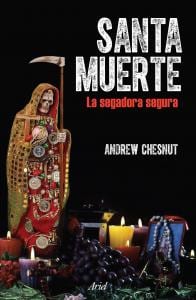
Since Chesnut penned this book, Santa Muerte has seen some changes. Enriqueta Vargas, the leader of Santa Muerte Internacional a transnational conglomerate of churches dedicated to the folk saint, died and was replaced by her daughter, Kristel. David Romo, a self-appointed bishop of a Santa Muerte church, remains behind bars after being arrested for running a kidnapping ring and laundering its ransoms through his personal bank account. Despite these leaders no longer being present, the faithful have only grown in number as Santa Muerte’s reputation as what Chesnut calls a ‘rapid and efficacious miracle worker’ extends not only across Mexico but beyond its borders across the Americas, Europe and even Asia.
The skeleton saint’s ever-increasing popularity is evident from the pullulating presence of devotees at Dona Queta’s famous Santa Muerte shrine in Tepito. Dona Queta, the woman who made devotion to death go public, is still going strong as a laissez-faire leader, and the renown of her shrine has only accrued. On November 1st, 2019, thousands of devotees flocked to the shrine in the notoriously dangerous neighbourhood in Mexico City to celebrate the 18th anniversary of Santa Muerte going mainstream when Queta first placed her altar outside in 2001. Carrying offerings on their knees, tattooed with images of the folk saint or perhaps bringing their own statuary to be blessed by the aura of Queta’s effigy, devotees assembled to pay homage to the figure to whom they attribute their well-being, as Day of the Dead festivities simultaneously descended upon Mexico City. But it is not only during celebrations that devotees visit the shrine, their presence is visible day in and day out at the Tepito shrine, even in times of coronavirus, when the faithful, masked and unmasked alike mingle to plead the skeleton saint’s favours.
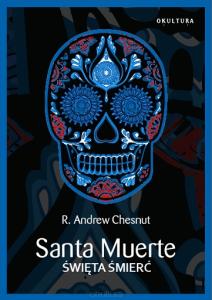
Eight years since its first edition, Devoted to Death remains the only exhaustive and scholarly single-author tome on Santa Muerte and her role in contemporary culture. Teaching a class at university on the anthropology of religion, with a special focus not so much on faith’s mysteries but above all on its functional role, I was drawn to Chesnut’s text. Not only does it evoke the mystical side of Santa Muerte –with devotees’ tales of magical apparitions of the folk saint who intervenes at vital moments to save them from death– it also alludes to the very practical and this-worldly wishes of the faithful who have pressing needs that they desperately yearn to be answered. Although these faithful might be narcotraffickers who need to get a shipment of drugs safely across the border –as Chesnut details in the black candle chapter– they might also be Mexican migrants in Richmond, Virginia, who long for love and supplicate the folk saint to matchmake them with a marriageable suitor, as detailed in the red candle chapter. The police, celebrities, lawyers, prisoners, and government officials all feature among the followers, as Chesnut details, and all also have their pressing needs that the multi-faceted, miraculous folk saint of death promises to resolve. Chesnut’s well-rounded account of Santa Muerte and her devotees thus goes beyond the sensationalistic depictions to be found in the media, of a saint associated with drug dealers and criminals. He situates Santa Muerte in a wider contemporary context as a pragmatic product within the Mexican spiritual supermarket thus elucidating the real reasons for the folk saint’s ever-increasing following.
Despite countering the media discourse of Santa Muerte solely as narco-saint-that is to say a saint venerated by narco-traffickers- Chesnut does not refrain from focusing on the media’s treatment of the folk saint nor her appearance in popular culture. From films, such as Paco Del Toro’s eponymous oeuvre, to narco-corridos (Mexican folk ballads glorifying narco deeds) he discusses her depictions in the media, whether as a love sorceress or as a dealer of death. Chesnut makes clear that whether in the media or musical odes alluding to her miraculous abilities, such portrayals whilst spreading fear of death also further belief in her powers. Moreover, such appearances must be considered integral to the saint’s ability to impel and infuse all aspects of Mexican popular culture with her mystical attributes. Chesnut also hones in on the saint’s important presence on social media, including the many Euro-American followers of the saint on Facebook and Twitter. Santa Muerte is increasingly visible online. There are
innumerable groups dedicated to her worship, in particular on Facebook where Chesnut’s photos, some from the website dedicated to the folk saint, skeletonsaint.com, which he co-curates with David B. Metcalfe, have been reformatted with the addition of prayers and redistributed as devotional images by devotees.
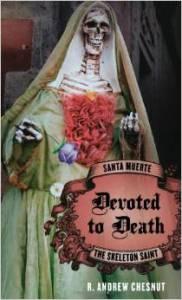
The saint’s virtual presence attests to the incessant dynamic of the new religious movement that is not only memetic but as Chesnut evinces is mobile and versatile. By exploring the wide range of representations of the saint, whether by devotees themselves or the media, Chesnut provides a 360-degree view of the new religious movement never failing to include the voices of devotees themselves and their testimonies. The inclusion of manifold voices from devotees of all walks of life, from devotional leaders to lawyers, ensures that Chesnut, although adding many a personal anecdote to this book, keeps the stories of the faithful front and centre. He never disputes assertions, such as intriguing allusions to Santa Muerte’s Aztec or Purépecha origins by followers, allowing the faithful to speak for themselves without colouring testimonies with his own assumptions. This makes certain that this book goes beyond other scholarship on the topic which has tended to mute followers of the folk saint in favour of academic opinion thus denying the reader an emic experience of death.
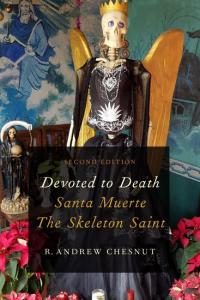
Devoted to Death is a rich exploration of an intriguing and rapidly growing new religious movement that can no longer be ignored, and the book deftly counters the misinformation on Santa Muerte that saturates the media emanating from television shows such as Penny Dreadful or Breaking Bad by revealing how and why devotees approach the saint. It is a welcome corrective to the White Western portrayals that would paint the faith as satanic or merely as Mexican exotica, bringing a fresh, down-to-earth, big picture perspective on the historical origins of the new religious movement, current praxis and the rationale behind religious devotion. I am grateful to Dr. Chesnut for bringing death and her devotees into my living room and my classroom. His sensitive, timely, and even humorous approach to the topic has greatly enriched my knowledge of the religious landscape of the Americas. Chesnut’s book is now a perennial favourite among scholars, religious practitioners and the general public alike, even appearing on the altars of devotees in the Americas and Europe who turn to the tome as a handbook to the faith. If the book has such a wide-ranging audience it is because its insights shine a light not only on a vital religious folk figure of the 21st century but also on the wide challenges that we all face and long to have resolved, whether problems in love, luck, finances or health. This is thus a book that speaks to us all, because sooner or later, we will all have to stare death in the eye. – Dr. Kate Kingsbury
*Dr. Kate Kingsbury obtained her doctorate in anthropology at the University of Oxford and is author of the forthcoming “Daughters of Death: The Female Followers of Santa Muerte” with Oxford University Press. She is a polymath interested in exploring the intersections between anthropology, religious studies, philosophy, sociology and critical theory. Dr. Kingsbury is Adjunct Professor at the University of Alberta, Canada. She is fascinated by religious phenomena, not only in terms of their continuity across the Holocene and into the Anthropocene but equally interested in the changes wrought to praxis and belief by humans ensuring the infinite esemplasticity that is inherent to all religions, allowing for their inception, survival, alteration, regeneration and expansion across time and space. Dr. Kingsbury is a staunch believer in equal rights and the power of education to ameliorate global disparities. She also works pro bono for a non profit organisation that aims to empower and educate girls in Uganda.



